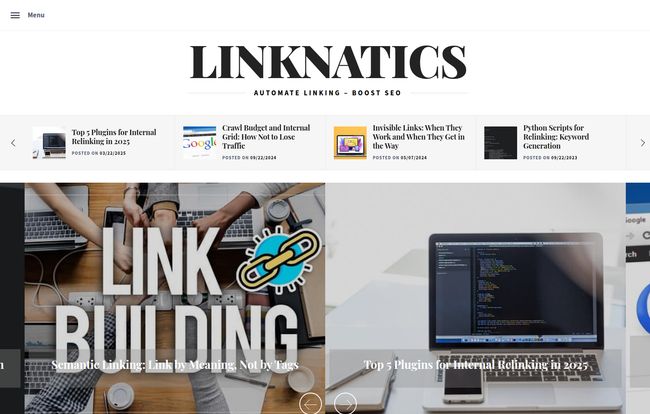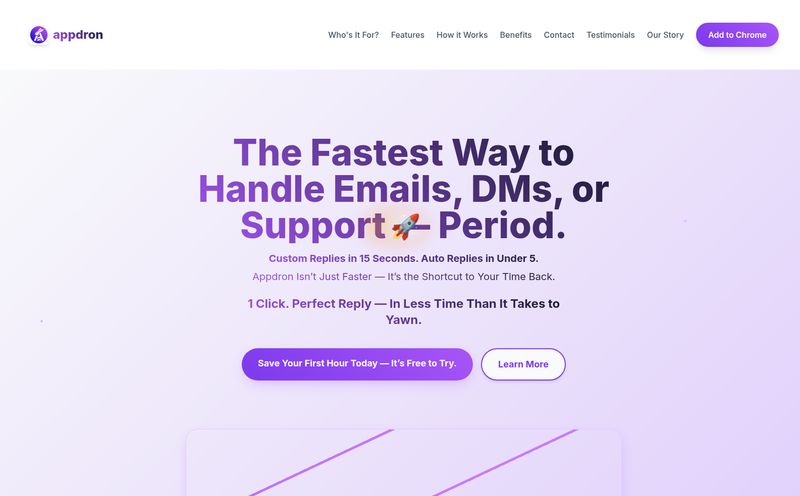Let’s talk about internal linking. It's the SEO equivalent of flossing. We all know we should do it. We nod along sagely in webinars when experts talk about distributing PageRank and building topical authority. We know it’s one of the few ranking factors we have almost total control over. But let's be honest, who actually enjoys it? The process can be a mind-numbing, spreadsheet-fueled slog, especially on a site with hundreds, or thousands, of pages.
It’s a necessary evil. So, when I heard about a platform called LinkNatics, which is entirely dedicated to automating this thankless task, my ears perked up. A tool to do the SEO chores for me? Sign me up. But my journey to check them out started with a bit of a laugh. The very first page I landed on? A big, fat 404 error. Ironic, isn't it? A platform dedicated to fixing and building links couldn't even keep one of its own alive. It was a perfect, human moment of imperfection that, honestly, made me more curious.
So, putting that initial hiccup aside, I decided to figure out what LinkNatics is all about. Is it the answer to our internal linking prayers, or just another tool promising the world?
What Exactly is LinkNatics Supposed to Do?
At its core, LinkNatics isn't just a single tool. It presents itself as a hub, a resource center, a brain trust for everything related to internal link structure management. The main promise is to help you automate your internal linking strategies. Think of it less as a simple plugin and more like a digital chiropractor for your website's skeleton. It aims to find the stiff, disconnected joints (unlinked pages) and create a perfectly aligned structure where information and authority can flow freely.
The goal is straightforward: save you a ton of time and, in doing so, boost your website's traffic by making Google’s job easier. When a search crawler can easily navigate your site, understand the relationship between your content, and see which pages are most important, good things tend to happen. Your crawl budget gets used more efficiently, your key pages get more authority, and users find what they need faster. It's a win-win-win.
A Look at the LinkNatics Playbook: The Blog
Before you get to any tools, the first thing you notice about LinkNatics is its blog. And I have to say, this isn't your typical beginner-friendly SEO content farm. They aren't writing posts titled “What is a Link?”. A quick glance at their article titles tells you who their audience is.
We're talking about heavy-hitting topics:
- Python Scripts for Relinking: Keyword, TF-IDF and BERT
- Semantic Linking: Link by Meaning, Not Just Keywords
- Internal Linking for SEO Silo Structure
- Link Whisper vs Internal Link Juicer: Who Wins?
This is stuff for the folks in the trenches. People who know what TF-IDF is and aren't afraid of a little code. They're talking about building proper SEO silos, a strategy that many talk about but few implement correctly. They're even pitting popular tools like Link Whisper against Internal Link Juicer, which is a fantastic way to capture traffic from people deep in the consideration phase. It shows they understand the competitive space.

Visit LinkNatics
This tells me that LinkNatics isn't for the faint of heart or the absolute beginner. It’s for the professional SEO or the technically-minded site owner who has moved beyond the basics and is looking for an edge. The content itself acts as a filter, attracting the right kind of user who can truly benefit from advanced automation.
The Core Features: What's Under the Hood?
While the blog provides the strategy, the platform itself is meant to provide the tools. Based on their pitch, the features are built around a few key pillars. You've got the automated internal linking strategies, which I imagine would involve AI or algorithmic suggestions for relevant links within your content. This is the main time-saver. Instead of you manually searching your site for an article to link to, the tool would theoretically surface the best opportunities for you.
Then there are the link structure management tools. This is the part that excites me. I'm picturing a dashboard that gives you a bird's-eye view of your site's architecture. It could flag orphan pages (pages with no incoming internal links), identify broken internal links, and maybe even visualize your topic clusters. This kind of diagnostic power is invaluable for maintaining a healthy site over the long term.
The Good, The Bad, and The Realistic
No tool is perfect, right? So let's break down where I see LinkNatics shining and where you might want to tread carefully.
Where LinkNatics Could Be a Game-Changer
The most obvious advantage is saving an insane amount of time. For an agency managing multiple large client sites or an in-house SEO for a massive ecommerce store, the hours spent on manual linking add up fast. Automating even 80% of that work could free up teams to focus on higher-level strategy. Furthermore, a tool that intelligently builds links can do a better job than a tired human at 4 PM on a Friday. It can analyze semantic relevance in ways we just can't, ensuring the link structure is not just complete, but also meaningful to search engines.
A Few Words of Caution
Here’s the reality check. First, this stuff likely requires some technical know-how. If you're not comfortable with concepts like SEO silos or what TF-IDF means, you might be in over your head. This isn't a magic wand. Second, and this is a big one, the tool's effectiveness is entirely dependent on the quality of your content. You can't create a strong, authoritative link structure out of thin, weak, or unrelated articles. Garbage in, garbage out. LinkNatics can help you weave the web, but you need to provide the strong silk threads first.
And yeah, that 404 page I found? It’s a small thing, but for a platform built around the concept of perfect linking, its a bit of a wrinkle. It suggests that you'll still need to keep an eye on things. Don’t expect to just set it and forget it.
The Million-Dollar Question: What's the Price?
This is where things get a little murky. After looking around, I couldn't find a public pricing page for LinkNatics. This isn't uncommon for specialized B2B tools or platforms that might be in an early access phase. It often means pricing is customized based on the size of the site or the specific needs of the client.
My educated guess? It's probably a monthly subscription model, similar to other serious SEO tools. I wouldn't be surprised to see tiered pricing based on the number of pages on your site or the number of users on your team. It's definitely not going to be a $49 one-time-purchase plugin. It's positioned for a more professional market, and the pricing will likely reflect that.
My Final Take: Is LinkNatics the Answer to Your Linking Woes?
So, what’s the verdict? I'm cautiously optimistic. I love the hyper-focus. In a world of all-in-one SEO suites that do a hundred things okay, a platform that does one thing—a really annoying, important thing—exceptionally well is always interesting. For the right user, LinkNatics could be a massive win. That user is likely an SEO professional, an agency, or a business with a large, unwieldy website that has outgrown manual linking processes.
If you're a small blogger with 50 or 100 posts, this is probably overkill. You can, and should, manage your internal links manually to maintain quality control. But if you’re drowning in spreadsheets and your site has more pages than you can count, LinkNatics might just be the life raft you've been looking for. It’s a space I’ll be watching.
Frequently Asked Questions about LinkNatics
- What is LinkNatics?
- LinkNatics is a platform and resource blog focused on automating the process of internal linking for websites. It aims to improve SEO, save time, and manage a site's link structure more effectively through specialized tools and advanced strategies.
- Who is LinkNatics for?
- It appears to be designed for intermediate to advanced SEO professionals, web agencies, and owners of large, content-heavy websites. The technical nature of its content suggests it's not aimed at beginners.
- Is LinkNatics a free tool?
- There is no public pricing information available, which suggests it is likely a premium, paid platform. Pricing may be customized based on client needs, a common model for specialized B2B software.
- Can LinkNatics replace manual internal linking completely?
- Probably not. Like most automation tools, it should be seen as an assistant, not a replacement. It can handle the heavy lifting of suggesting and placing links, but human oversight is still crucial to ensure quality, context, and a natural user experience.
- How does automated internal linking help SEO?
- A well-structured internal linking strategy helps search engines like Google discover all your pages, understand the topical relationships between them, and pass authority (or "link juice") to your most important content. This can lead to better rankings and a more positive user experience.
Reference and Sources
- Internal Linking for SEO: An Actionable Guide by Ahrefs
- Moz's Guide to Internal Links
- Link Whisper - A popular internal linking plugin for WordPress
- LinkNatics Official Website



